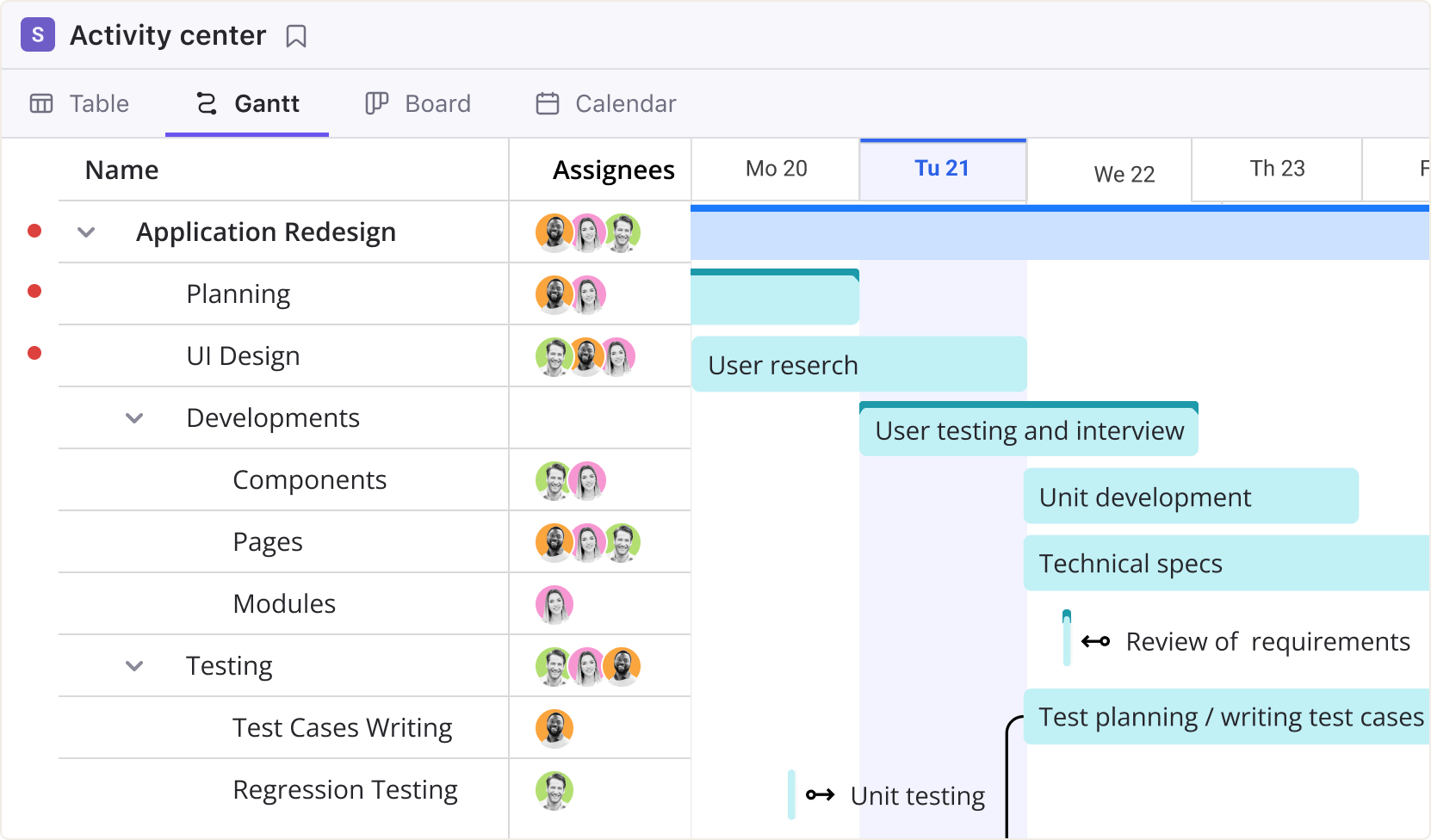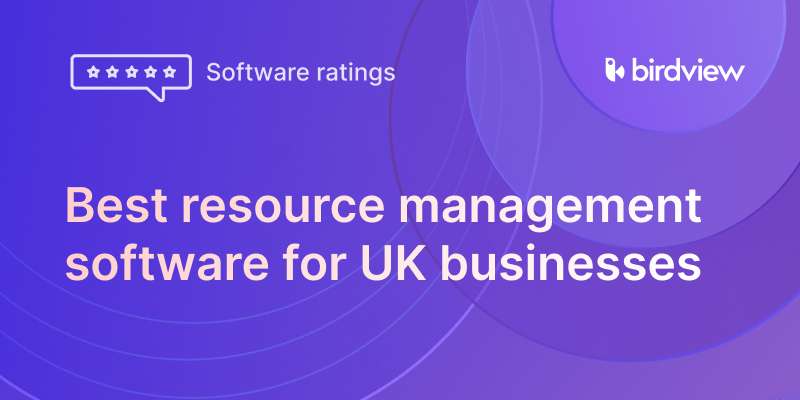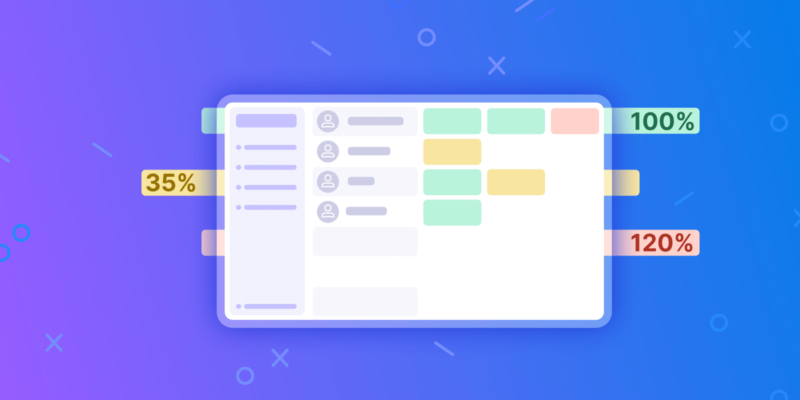When managing projects of varying complexity, project managers inevitably face the challenge of utilizing resources efficiently, particularly human resources. They must skillfully balance the importance of meeting project deadlines with the goal of achieving financial success. Masterfully combining resource leveling and resource smoothing ensures your team stays balanced, productive, and prevents burnout. Let’s dive into what these techniques entail, their differences, and how to apply them effectively in project management.
What is resource leveling?
Resource leveling is an essential technique for when resource availability becomes a critical concern. It involves meticulously adjusting the start and end dates of tasks to prevent over-allocation of resources. While this may often mean extending the project timeline, it ensures that every team member is working within their capacity, ultimately leading to a more sustainable and manageable project.
Benefits of resource leveling
For a project manager, there are many benefits to using resource leveling. By adjusting project timelines according to resource availability, we can prevent delays and ensure successful project completion. The resource leveling method distributes tasks evenly, minimizing burnout. It also provides clear insight into resource allocation and timing, facilitating informed decision-making. We can easily track progress, identify potential problems early, and make necessary adjustments. This method helps keep projects within budget constraints, reducing the risk of cost overruns.
Disadvantages of resource leveling
As a project manager, I’ve found that while resource leveling is crucial for maintaining balanced workloads and preventing burnout, it comes with its own challenges. By distributing tasks evenly and aligning them with available resources, we can avoid overloading our team members. However, this approach often results in longer project timelines, increased complexity in schedule management, and potential delays when responding to high-priority tasks. Balancing these factors requires a strategic and thoughtful approach, ensuring that we meet project goals while keeping our team engaged and productive.
Read more:
What is resource smoothing?
As a project manager, I rely on resource smoothing when meeting project deadlines is absolutely critical. The primary objective is to tweak the project schedule in a way that makes the most efficient use of our resources while keeping the project’s end date intact. This approach involves redistributing tasks to level out the demand for resources, ensuring there are no sudden spikes or dips. By doing this, we can maintain a steady workflow and ensure that our team remains productive and on track without compromising the project’s overall timeline.
Benefits of resource smoothing
When allocating resources, I see many benefits to using the resource smoothing method. This approach ensures a consistent and manageable workload for my team, preventing the stress associated with fluctuating resource demands. It improves efficiency by utilizing available time without altering the project end date. By avoiding overload, resource smoothing reduces stress and burnout, enhancing resource management to ensure team members are neither overextended nor underutilized. This balanced work environment boosts the productivity and quality of the project team. Additionally, resource smoothing provides flexibility in project execution, allowing for minor schedule adjustments to handle unexpected changes without affecting the overall timeline. This method facilitates better planning and forecasting, making resource use more predictable and stable, and reducing the likelihood of last-minute changes or emergencies.
Disadvantages of resource smoothing
Resource smoothing is a strategy I rely on to maintain a consistent workload by adjusting task schedules within their available float time. This method is crucial for keeping our team productive and preventing burnout. However, it has its own set of challenges. While smoothing creates a balanced workflow, it can complicate project management. Delays in critical tasks can cascade through the project, and the frequent need for adjustments can increase administrative efforts. Despite these challenges, resource smoothing is essential for fostering a steady and efficient work environment.
Read more:
Key differences between resource leveling and resource smoothing
As a project manager, understanding the nuances between resource leveling and resource smoothing is crucial for effective project planning and execution. While both techniques aim to optimize resource utilization and ensure timely project completion, they differ significantly in their approaches and outcomes.
Resource leveling adjusts the project schedule to address resource constraints, often resulting in changes to the project timeline. This method is particularly useful when specific resources are limited and cannot be over-allocated, even if it means extending the project duration.
On the other hand, resource smoothing focuses on maintaining a steady workload by making adjustments within the existing project timeline. This technique aims to minimize fluctuations in resource usage without altering the overall project end date, ensuring that team members have a balanced and manageable workload.
| Resource Leveling |
Resource Smoothing |
| Project’s finish date: The project’s finish date is fixed. | Project’s finish date:The project’s deadline isn’t fixed and can be adjusted easily. |
| Priority: Prioritizes resource availability, adjusting project timelines as needed. | Priority: Prioritizes maintaining the project end date, and adjusting task schedules without changing the overall timeline. |
| Impact on Schedule: Can extend the project timeline to accommodate resource constraints. | Impact on Schedule: Keeps the project timeline intact, redistributing tasks to balance resource demand. |
| Flexibility: Offers more flexibility in handling resource constraints but can delay project completion. | Flexibility: Maintains project deadlines but may reduce the ability to handle unexpected changes. |
Combining both techniques resource leveling and resource smoothing
In practice, project teams may need to combine resource leveling and resource smoothing to effectively manage resources and meet project goals.
For example, during a peak period, a marketing agency might use resource leveling to prevent overloading key team members and resource smoothing to ensure critical deadlines are met.
Understanding these key differences between resource leveling and resource smoothing allows us to apply the right method based on the specific needs and constraints of our projects.
How to combine resource leveling and resource smoothing in Birdview PSA
Managing resources effectively requires a project manager to blend resource leveling and smoothing. With Birdview PSA, you have all the tools you need to ensure smooth project execution and a balanced workload.
Resource leveling addresses immediate constraints by rescheduling tasks based on resource availability, even if it means extending project timelines. Birdview PSA‘s Gantt chart view and drag-and-drop functionality make this process straightforward, allowing us to adjust schedules easily.

Resource smoothing, meanwhile, focuses on maintaining a consistent workload without changing the overall project end date. Birdview PSA‘s resource utilization reports provide insights for adjusting task dates within their float time, helping us avoid workload peaks and troughs.

By integrating these techniques, we can address resource constraints while maintaining a steady workflow. Birdview PSA‘s real-time data and collaboration features ensure continuous monitoring and communication, allowing us to make timely adjustments and keep the team informed.
This balanced approach ensures your projects are completed on time, within budget, and with optimized resource usage.
Read more:



